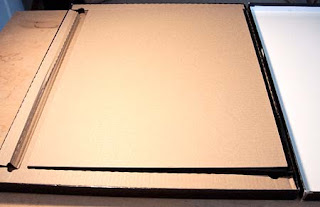Yesterday I did a client print job that included 19 prints, all on EEF (a gloss paper, requiring PK ink). Four were on 17 x 22 inch sheets (US C). One was on a 13 x 19 inch sheet (Super A3/B). The remaining 14 were on (US) letter-size sheets. There were no problems with the printing; the 7900 performed flawlessly, as it nearly always does.
However, the preparation for this print job was the most frustrating experience I've had with my printer so far. Here's the story:
I'd done some print jobs last week on matte papers. Prior to starting yesterday's job I had to swap MK for PK. Not a problem. Press the button, the machine swaps the inks. I've learned this process will automatically perform a cleaning when the next print job is sent. I made that next print job a nozzle check print, which I initiated from the printer's control panel.
I immediately got the set of messages I showed and described in
my previous posting. One of the ink levels was too low for cleaning. I needed to replace that ink before cleaning could continue. But which ink? The printer doesn't tell you.
Perhaps my problem is partly my own fault. There are 11 inks in this printer. Eight of those 11 in my printer are at 4% or lower. But I've made dozens of prints with ink levels at 1%, and see no reason to replace inks if the machine will continue to print with them. It may be necessary to replace an ink cartridge for cleaning, but Epson makes it quite clear that, once the cleaning is finished, the nearly empty cartridge can be re-installed and used until it's empty. That's what I do.
I've heard, and seen some evidence myself, that if an ink is at 5% or below, the 7900 will require installing a new (or at least, more full than 5%) cartridge before cleaning can continue. In any case, I had no idea which ink to change. Since I'd just done the MK-to-PK swap, I guessed I needed to replace my PK, which was at 4%. I installed a new PK. Replacing an ink cartridge requires pressing a button, choosing from a menu whether to open the left, right, or both ink compartment doors, replacing the ink cartridge, closing the door, and then waiting a minute for the system to pressurize. After all that for the PK replacement, the printer displayed the "Ink too low to clean" message again.
Which ink to change? I made a guess, replaced that ink, and again the machine displayed its "Ink too low to clean" message. To shorten the story, one at a time I replaced a total of seven ink cartridges before the machine would proceed with the cleaning. Fortunately I had a complete set of inks on hand.
When the cleaning finished, I removed all the new inks, returned the low-level cartridges to the machine, and then began printing. I was able to complete the job, and run several more prints today, without issue.
Epson: please,
please give us a firmware update that identifies the ink(s) that must be replaced for cleanings! The current process is intolerable.
--Jay





